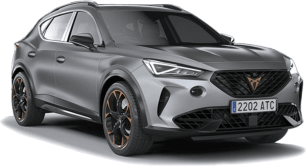The design sells a car which is more individualistic than some of its rivals or relations, and this certainly felt true in my week with this Cupra. The big front seats, for example, are accommodating and supporting, allowing a sporty, low seating position and a good level of adjustability for the steering column.
The doors have a big bottle holder in them, and there are a further two in the raised centre console element. This area is also enhanced with a small bay thanks to the minimalist fly-by-wire controls, good for holding another phone, wallet, or perhaps keys. There is also an adjustable-height centre armrest covering a small storage box.
The area under the screen hosts dual USB-C ports as well as a wireless charger. Although we’ll call out here there’s no mechanical controls for the climate functions, which like all modern VW Group vehicles, need to be managed through some touch elements below the multimedia screen, or, more frustratingly, through the screen itself.
The screen is interesting, because it’s not one of the crazy high resolution ones which appear in some VW Group products, instead being a faster, lower resolution version, which has the benefit of making the touch elements in CarPlay or some of the sub menus large and easy to jab at while on the move.
The software is mostly good, too, with a handful of fairly self-explanatory menus, with some more advanced features buried about two menus deep, best adjusted while parked. There’s a clever little short-cut bar on the left-hand side of the screen, even when CarPlay is running, which lets you skip right to the main menu, car settings, or climate functions.
The digital dash has a welcome variety of views to play with to suit all kinds of preferences, and some bespoke Cupra ones which look neat, too.
In my week with the car, I had some passengers complain that the rear seats feel very claustrophobic with the massive front seat backs blocking the view out the front of the car, and a combination of black headliner and a large transmission tunnel closing in the space further.
I tend to agree, although I (at 182cm) had sufficient airspace for my knees behind my own driving position as well as sufficient headroom, with the only small annoyance being how low the doorline is. If you’re as tall or taller you’ll need to duck low to get in.
Welcome additions to the second row include a large bottle holder in each of the doors, dual USB-C outlets, and the third climate zone with adjustable vents is a real win.
Boot space is 345 litres. Sounds middling for the small SUV segment, and down on the 420 litres offered in the purely combustion variants, but I was pleased to find it could accept the entire CarsGuide luggage set with minimal disruption to the view out the rear window. I did have to remove the luggage cover, however.
There is no under floor storage with a small cutaway for the tyre repair kit, so you will need to store your charging cables in the boot.






































.png)























